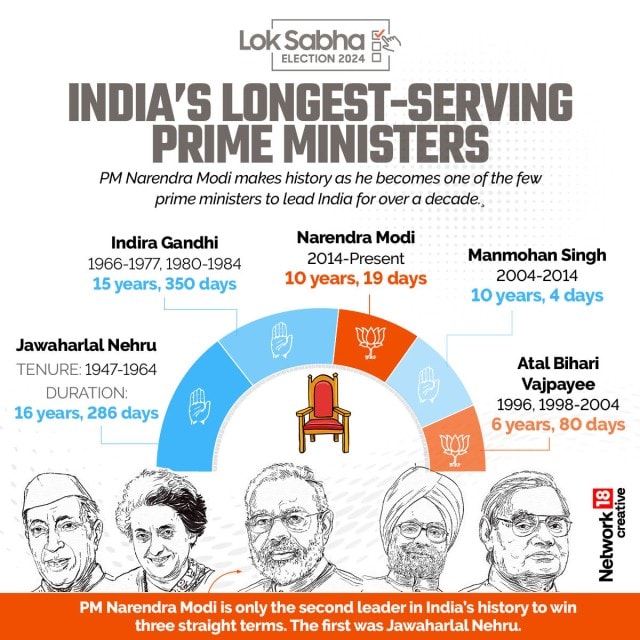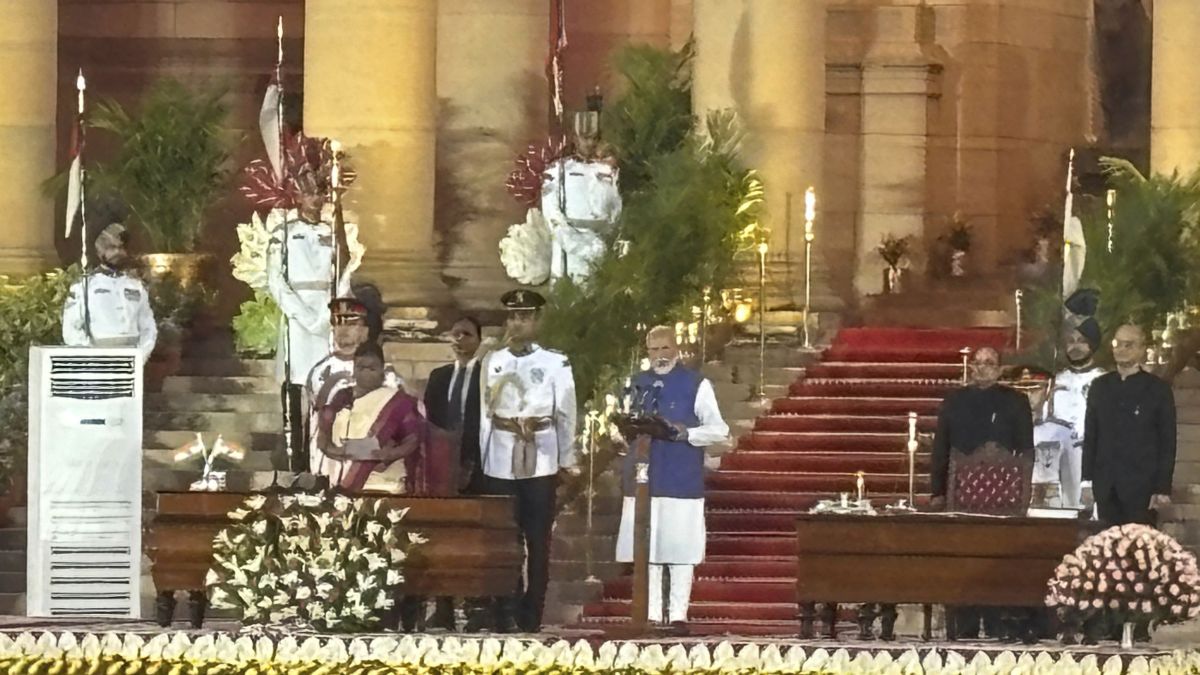In front of almost 8,000 guests, including world leaders, prominent businessmen and film stars, Narendra Modi took the oath as prime minister in the forecourt of Rashtrapati Bhavan for a historic and record-equalling third time.
His oath of office comes after the BJP-led NDA secured the magic number of 272. However, it’s important to note here that BJP’s numbers in Lok Sabha have dropped below the majority mark, making it more reliant on allies such as the Nitish Kumar-led Janata Dal-United (JD-U), Chandrababu Naidu’s Telugu Desam Party and Jayant Chaudhary’s Rashtriya Lok Dal (RLD).
Despite the path, Narendra Modi has indeed made history today and become one of the few prime ministers to lead the nation for over 10 years. Out of India’s 14 prime ministers, the 73-year-old currently holds the title of fourth-longest serving leader.
Let’s take a closer look.
Jawaharlal Nehru
Party – Congress
Tenure – 1947-1964
Duration – 16 years, 286 days
Nehru was India’s first and longest-serving prime minister, who led the country from 1947 until he died in 1964.
He was instrumental in modern India’s development, having started several major initiatives that included big businesses, dams, and the growth of science education.
India maintained its independence from both the US and the USSR throughout the Cold War thanks in part to Nehru’s non-alignment foreign policy.
His lasting influence on every aspect of the nation’s growth stemmed from his vision of a secular, socialist India, which shaped his policies.
Impact Shorts
More ShortsIndira Gandhi
Party – Congress
Tenure – 1966-177, 1980-1984
Duration – 15 years, 350 days
Indira Gandhi, the country’s first female prime minister, was known for her bold decisions and divisive policies.
Major events such as the Green Revolution, the Emergency (1975–1977), and the nationalisation of banks occurred during her term in power.
Additionally, she guided India to victory over Pakistan in the 1971 war that resulted in the creation of Bangladesh.
Her influential career was tragically ended in 1984 by her assassination.

Narendra Modi
Party – BJP
Tenure – 2014-Present
Duration – 10 years, 19 days
The current PM Modi has secured a hat-trick third consecutive term after assuming office in 2014.
Under his leadership, he has implemented numerous ambitious projects that have garnered recognition at home and globally. These projects include digitalisation, economic transformation, and innovative foreign policy.
The 73-year-old’s second term, which started in 2019, was centred on global engagement, infrastructure, and economic revival.
Modi began his election campaign for the 2024 general elections by showcasing his record in office, including economic growth, welfare policies, national pride, nationalism and his own personal commitment to fulfilling promises, which he called “Modi’s Guarantee.”
With 293 seats, his BJP-led NDA alliance won handily, despite a valiant effort by the Congress-led INDI Alliance, which won 232 seats.
Modi called the win for his alliance historic and said, “We will continue the good work done in the last decade to keep fulfilling the aspirations of people.”
In a post on X, he wrote, “People have placed their faith in NDA, for a third consecutive time! This is a historical feat in India’s history. I bow to the Janata Janardan for this affection and assure them that we will continue the good work done in the last decade to keep fulfilling the aspirations of people.”
“I also salute all our Karyakartas for their hard work. Words will never do justice to their exceptional efforts,” he added.
Manmohan Singh
Party – Congress
Tenure – 2004-2014
Duration – 10 years, four days
Renowned economist Manmohan Singh led the country as prime minister for a decade.
He is credited with carrying out the economic changes that accelerated India’s growth in GDP.
His government strived to advance India’s infrastructure and technology while enacting significant laws like the Right to Education Act.
Singh is respected for his cool-headed leadership approach, even though some criticised his policy stagnation later.
Atal Bihari Vajpayee
Party – BJP
Tenure – 1996, 1998-2004
Duration – Six years, 80 days
Vajpayee led the country as prime minister three non-consecutive times.
He gained prominence in 1998 with the Pokharan tests, which established India as a nuclear power.
In addition, he initiated significant infrastructure projects such as the Golden Quadrilateral highway network and tried to strengthen ties with neighbouring Pakistan, signing the 1999 Lahore Declaration.
During his term, he implemented a balanced approach that blended social efforts with economic success.
With inputs from agencies
)